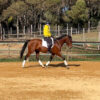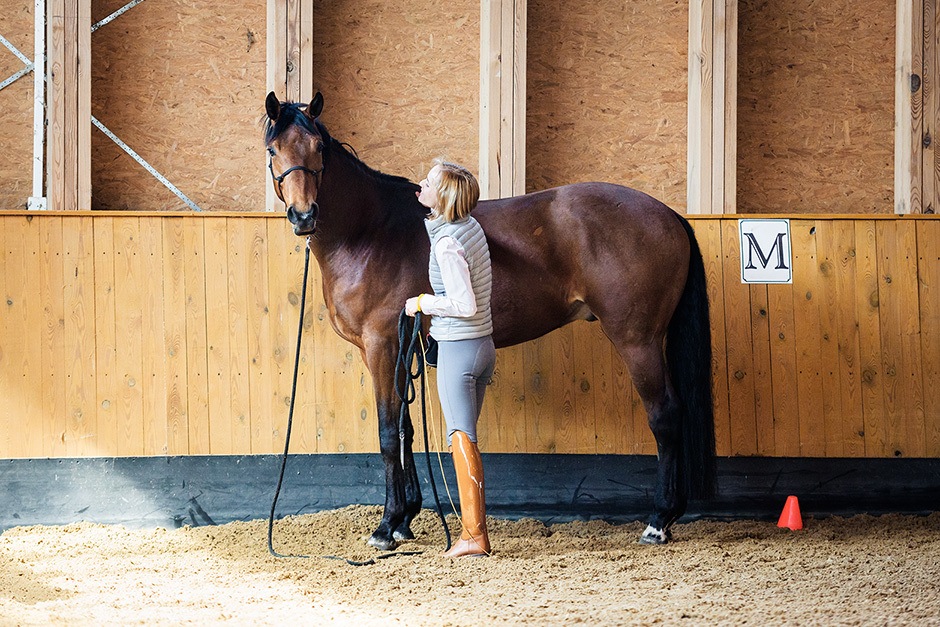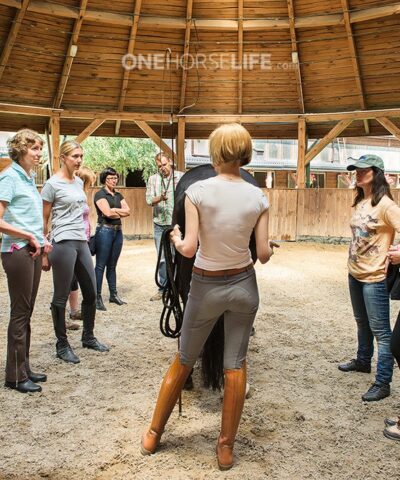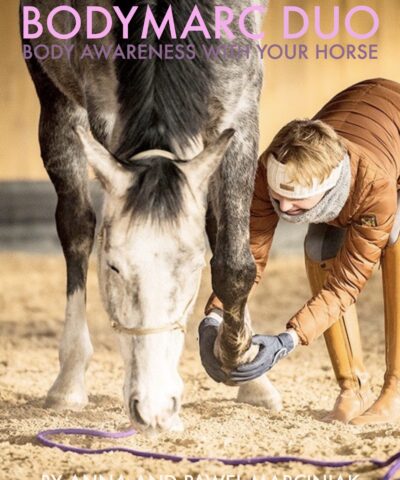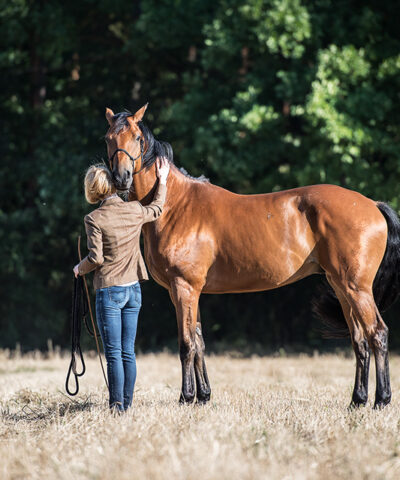Description
RELAX THAT STOMACH PRO TEACHER COURSE’S PROGRAM:
WEEK 1: RELAXATION. WHAT, WHY & HOW?
What is Relaxation?
Relaxation versus Action
10 MOST COMMON TRAPS OF Relaxation Training
PRO TEACHER MODULE: How to stop an activity so that it becomes relaxation, and how is it possible to build a training system for sport performance around not doing something?
WEEK 2: RELAXATION SIGNS VERSUS CALMING SIGNALS
The bad and the good policemen:
Relaxation Signs
Calming Signals
How to know and tell the difference between the both?
Relaxation Signs as a tool in Training Relaxation
Calming Signals as a tool in Measuring Stress
When & How Relaxation Signs turn into Calming Signals
WEEK 3: CONSCIOUS & UNCONSCIOUS RELAXATION
PRO-TEACHER MODULE: How to turn an unconscious occurance into a consciously performed skill
How do horses & humans become aware of unconscious activities
How do horses & humans turn unconscious actions into conscious skills
How a conscious skill becomes a relaxation technique
WEEK 4: RELAXATION
History of Relaxation oriented studies and Relaxation Know-How
Why modern relaxation is hardly ever true relaxation – the traps on the road for a relaxation trainer newbie
Building Teaching & Training based on relaxation – the goals, the missing links, and the real-life approach
Role of the internal organs in the perception of fear
Barometer of body stress: Why does the Stomach respond first?
WEEK 5: RELAX THAT STOMACH Technique, theory BLUEPRINTS
PRO TEACHER MODULE: Relax That Stomach Step by Step Guide for Teachers. An in-depth insight into the “coder” version of the Relax That Stomach Technique.
BLUEPRINT: Teaching horses
BLUEPRINT: Teaching other people
BLUEPRINT: Making one’s technique pure
What may go wrong & how to solve it (10 golden rules of teaching relaxation)
WEEK 6: RELAX THAT STOMACH Technique, practical BLUEPRINT
Technique adaptations for Teachers:
Relax That Stomach Technique for horses who don’t move
Relax That Stomach Technique for anxious horses
Relax That Stomach Technique for horses with behavioural issues (aggressive behaviours)
WEEK 7: STUDY YOUR CLIENT
PRO TEACHER MODULE: Tension scale for Relax That Stomach Technique
How to measure horse’s stomach tension
WELL BEGUN IS HALF DONE: Relax That Stomach Technique introduction adaptations & modifications for horses with different tension level
WEEK 8: STUDY YOUR CLIENT
PRO TEACHER MODULE: Relaxation’s misconceptions, biases, and mistruths – Introducing your clients to the fascinating world of Relaxation Based Training.
Adapting and introducing Relax That Stomach Technique in a way that works: the DOs and the DON’Ts of Relaxation Technique while working with other people.
WEEK 9: RELAX THAT STOMACH CASE STUDIES
Stomach issues in horse performance, health, and behavior changes.
This module will go through the 10 most difficult cases that we have encountered while teaching the Relax That Stomach technique to clients’ horses. We will share with you the most challenging problems, the issues, and how horses were presenting them, and we will share with you the detailed training plan solutions that have worked.
WEEK 10: TRAINING SESSIONS PLANNING
Training Session plans for horses of different ages, sex and degree of tension
Training Session plans for horses with a history of colic and ulcers
Training Session plans for foals and young horses
Training Session plans for horses in pain
Training Session plans for sports horses and how to incorporate the technique in the sports horse training routine
WEEK 11: LONG TERM and SHORT TERM APPLICATIONS
Relax That Stomach Technique in short-term application: WHY, HOW, and WHEN?
Relax That Stomach Technique in a long-term application:
- Relax That Stomach Technique as a healing tool
- Relax That Stomach Technique for behavior modification
- Relax That Stomach Technique in the competition environment
Relax That Stomach Technique in young horse training and starting horses under the saddle
WEEK 12: TEACHING OTHERS
PRO TEACHER MODULE: SEMINAR, CLINICS and private lessons plans
How to teach relaxation to client’s horses.
How to make sure your students are still doing relaxation with their horses even if you are not watching: the art of passing pure technique.
WEEK 13: KEEPING THE SUCCESS ROLLING
Relax That Stomach Technique & everyday life and training with horses:
How to smoothly and effortlessly blend Relax That Stomach Technique in your client’s equestrian life with her/his horses
How to ensure same, repetitive results over time
How to keep the technique pure and working
PRO TEACHER MODULE: Signs of going off-track, and how to come back to the pure technique for maximum results
WEEK 14-16: YOUR PRACTICE WITH CLIENTS HORSES
Relax That Stomach Technique practice with your first clients’ horses under supervision of Anna and Pawel Marciniak, inventors of the Relax That Stomach Technique
QUALIFICATION TEST
__________________________________________________
RELAX THAT STOMACH Technique empowers horses to become healthier, more balanced, and more connected — through relaxation — versions of themselves.
-
- Do you know that you can change the body shape, training attitude, facial expressions, and even reach and fluidity of your horse’s steps just by releasing tensions from his stomach?
- Do you know that biting, nipping, irritation without the reason, over-sensitivity (up to irritation) in response to touch and even sudden unjustified spookiness are signs of tensions of the smooth muscles of stomach and intestines?
- Do you know that you can change social relationships of your horse and his herd interactions with other horses by teaching your horse how to choose Relaxation over Tension in food context (sharing hay, meal times) and excitement context (play, social interactions involving higher emotions)?
- Do you know that the technique which you are going to learn so powerful that it can even change the amount of forage your horse eats every day?
During this MEGA TEACHER COURSE all participants will learn THREE POWERFUL RELAXATION TECHNIQUES for digestive tract and stomach, and they will gain the abilities to pass these techniques in a PURE, SUCCESSFUL, DETAILED yet SIMPLE and EFFECTIVE way to horses and horse owners world-wide.
Our goal is that all Future Teachers of the Relax That Stomach Technique become a POWER OF GOOD FORCE in life of horses and humans, allowing thousands of horses all over the world to START A NEW LIFE, and TURN THE PAGE leaving chronic illnesses, disturbing behaviours, spookiness, grumpiness, and physical stiffnesses and pains – originating from the tension-run inflammation of the digestive tract – behind.
“Thanks to the Relax That Stomach Technique we had COMPLETELY got rid of the ulcers, and from severe asthma we had gone down to a mild inflammation of the airways”
Read the testimonial below:
“I was 11 when I got my first I didn’t know how to gallop yet, and my only riding experience had been at a local riding school. So my horse and I shared many firsts – the first gallop, the first jumps, the first field trips. But what was also new to me and what I liked very much was the opportunity to spend time alone with my own horse, getting to know his likes, his character, who he was. And somehow, intuitively, we were good at strengthening the bond. Often when I left him in the paddock with other horses, he would jump over the fence to gallop back to me at the stables where I was preparing to catch a bus home.
We spent a lot of time together. Long summer days bathed in sunshine and cloudy afternoons. I wanted to create a nice relationship with my horse – to be a couple like those seen on the internet. I found a lot of information there about methods of building relationships based on pressure-release and the theory of herd dominance. I bought a training package from one of the natural horsemanship schools based on this way of working, and we started a phase lasting about 3 years. During this time, my horse became an apparently reliable horse. He seemed to accept this method easily. It was enough to look at the croup from a certain angle and he was already moving it. Observers watching us said he was like a lamb – well-mannered, polite, calm in his surroundings, you could do anything with him.
However, in time I began to notice that despite the fact that he would perform all the exercises, even at liberty without a rope or lunge, and there was nothing I could not do with him, his youthful enthusiasm, which had so captivated me when I first saw him, had somehow faded away. He began to be slow, less eager to move.He began to tighten the nostrils and curl up his ears, not only while working, but also in relation to other horses in the paddock. He became uncooperative and often irritable. Friends and the people around us were laughing at us now, saying you had to walk on eggshells and be careful not to upset him by accident with some little unimportant trifle. In the stable yard he got the label of an unpleasant horse who said no to everything and was always dissatisfied.
Another disturbing thing was that he started to lose weight in the Spring and he lost muscle in the Fall.And then finally one day he got a colic that lasted 5 days and ended up in a veterinary clinic. It turned out that he had ulcers. He was prescribed medication and rest. We went through the rehabilitation process but his dissatisfaction and lack of interest in his surroundings remained the same. Now he disliked anything I did with him. Tense nostrils and ears were a permanent element of our daily life and training. I tried various methods to change this, including positive reinforcement. However, nothing worked. My once-cheerful, kind, charming horse had become a stable goblin. It discouraged me so much that eventually even the hope for change was gone.
We did nothing for the next three years. In the meantime, we did a control gastroscopy. Despite systematic treatments and supplementation his ulcers and scars were still present. I was tired of constantly trying to treat and rehabilitate a horse that I couldn’t do anything with without him expressing his unhappiness. I even considered retiring him at the age of 12.
Fortunately, when we were at rock bottom, I summoned my last bit of strength to give it one last try and hope that things could change between my horse and me. I discovered OneHorseLife and Anna Marciniak’s methods. I was very impressed and touched by what I saw in her videos. I watched her horses performing the elements of dressage from the ground with great joy and enthusiasm, full of energy, loose, alive, and working with every cell of their bodies. There was not a gram of compulsion or anything artificial in it. I thought “THIS IS IT. I was looking for this!”
I decided this would be my final test, trusting one last method after dozens of ineffective ones that hadn’t worked for my horse. I bought the Optimal Performance Program course [with a RELAX THAT STOMACH technique in it], and we have been writing a new story since then. I understood how tensions in the body, especially in the internal organs, affect well-being and movement. From the very first sessions, we started working on relaxing my horse’s stomach, and that was our game changer.
By doing one short and simple exercise with a bucket every day, his mood and thus his behaviour changed from month to month. He began to feel better about himself. I realised that labelling him as “grumpy horse” did not define his true character, but only the tensions that limited him. He was changing a lot. He started playing with the horses in the paddock. From a horse that was always 10 meters from the rest of the herd, he turned into one that welcomes his buddies.
We went back to work. I hadn’t thought I would ever progress to seeing his ears forward and a pleased expression in the trot! Or that his movement could be springy, loose, energetic. We also returned to riding, in contact with the bit, not just in a halter as I had before. In the end I was able to easily ride my own horse in the pasture, whereas before I’d had to battle his constant tension and desire to rush back to the stable, my fingers sore from holding him back with the reins. We started doing a lot of things, having plans, common goals. Our life together had turned 180 degrees.
After a few months, however, we had a temporary deterioration in his health and general well-being. It turned out to be asthma. Doubt returned. The vet said it was a serious condition, and he couldn’t know how it would be affected by further training or work. However, we did not give up. We continue to work on relaxation and tension release up to the present day.
Recently, I decided to do a control gastroscopy and bronchoscopy. The results shocked even the vet doing the test, one of the top vets in Poland. It turned out that we had COMPLETELY got rid of the ulcers, and from severe asthma, we had gone down to a mild inflammation of the airways. “I haven’t seen anything like that,” she said, seeing the image from the camera on the monitor. No drugs, no steroids, and no supplements. Just relaxation [as taught in the OneHorseLife Programs]. Healing the whole organism from the inside, from the internal organs, from the belly.
My gratitude to you, Anna, is indescribable for what you do for others and how you change the lives of thousands of people and their horses, including mine and my horse’s. We are digging into deeper and deeper tensions, and I believe there is still a lot to be found before us.
Martyna, Poland, and horse Pablo.”
WHY SOME HORSES CANNOT RELAX ON THEIR OWN AND NEED HUMAN HELP?
All horses, just like all healthy and already relaxed living beings, have the natural ability to come back to the state of relaxation if it gets disturbed. We call it spontaneous relaxation. It occurs spontaneously, and without a conscious awareness or conscious participation of the one who is relaxing. You can see horses relax on the pasture, while taking a nap, scratching and socialising with one another in a relaxed manner. However, this doesn’t mean that relaxation that you see is a conscious process, and a conscious choice. And there is one more catch here: in order to occur the spontaneous relaxation processes need the body of the horse to be already relaxed at some level. Once this level is exceeded by, for example, a stressful lifestyle, natural predisposition to get tenser, or for example an unexpected exposure to external stressors and triggers (like a nervous horse in a stable or paddock next to your horse), or even a mild inflammation — it becomes harder for the body to remember path back to relaxation.
This is when horses struggle the most, and show most tension-based behaviours. These are the horses who become grumpy, irritated, “leave-me-alone” types. They react to anything and everything by tensing up, becoming negative. These are the horses who don’t eat, or eat too much, who “go nuts” over a carrot and cannot focus at all and hold their composure and calmness in face of food. These are the horses who are suffering from laminitis, ulcers and colics, from asthma and breathing patterns disturbances, and who gain weight just by “looking at food”.
Training and taking care of such horses is complicated, because the regular training techniques of behaviour modification are built in such a way that while teaching behaviours, they reinforce and prolong (or even make greater) the state of the tension in which the animal already lives.
Trapped in this vicious circle, the horse is changing ways in which he communicates his tensions, going from mild irritation to flies to getting irritated at being touched, at the saddling and girthing up, at being asked to do things, by showing reluctance to move and the owners focus on solving the behaviours the horse is presenting, but his body stays still tensed. Transfers the problem deeper and deeper, causing gastric problems, problems with weight maintenance, dermatological problems, chronic itchiness, chronic inflammation in the body, laminitis, problems related to the use and assimilation of feed, training and behavior problems…
We want to prepare and send out there our TEAM OF RELAX THAT STOMACH TECHNIQUE EXPERT TEACHERS with a mission to help these horses and these horse owners to MOVE FORWARD, START A NEW LIFE and NEVER LOOK BACK!!
THE MOST IMPORTANT SIGNS of that a horse suffers from digestive tract / stomach smooth muscle tensions:
- EATING PROBLEMS: Some horses respond with overeating and other with under-eating to the tensions of the stomach. Some horses will become crazy about the food up to the point of getting colicky by skipping drinking in favour of eating, and other horse owners will report that their horses lose weight and it is hard to keep the muscles on their horses, even with best feeding programs and exercise regimen. It all depends on how the horse responds to pain originating from the digestive tract,
- IRRITATION: with and without a reason, “angry” look on the face when being approached or touched, becoming more and more irritated even during activities which were problem-free before, pulling out the faces even if trained using positive reinforcement and best intentions,
- SPOOKINESS: sudden and unexpected bursts of spookiness, and becoming gradually more and more anxious and scared of everything around,
- LACK OF DESIRE TO MOVE: lack of interest to move, horse owners report that they need to motivate their horses to move,
- STIFFNESS IN THE BODY: the horse doesn’t move fluidly and it feels as if his legs were tied,
- INABILITY TO WORK THROUGH THE BACK: A very common question asked to horse body therapists by horse owners: “I work my horse every day but he doesn’t grow his back muscles, why?” – We already know an answer to this question and it is a tensed stomach.
- ILLNESSES: to ulcers, colics, sensitivity of the digestive tract, laminitis, asthma, allergies, sweet itch, breathing problems,
- ANGRY EXPRESSION: horse shows tricks with anger, so called “angry/stomping” Spanish walk, working as if only for the treats,
- HEAVY EXPRESSION: when standing still, and while in the movement, lack of lightness in the gaits, heaviness, the trainer feels as if he has to “push the horse forward” with every step, heaviness on the bit, halter, pulling against the intention of the trainer/rider,
- SENSITIVITY TO TOUCH: horse doesn’t like to be cuddled, escapes affection, feels distant and shut down,
- REDIRECTING STRESS/PAIN: teeth grinding, tail smashing, biting fences, and stable walls, in more serious cases: biting oneself: the horse bits his sides, his leg, other horses, or leg of the rider who mounted him.
- “MOUTHINESS” WITH THE BIT: biting the bit, chomping on the bit, problems with acceptance of the bit.
Over the years the Relax That Stomach technique, a unique technique focused on teaching horses how to relax their digestive tract, with stomach in the limelight have proved itself to be one of a kind technique providing both long term healing effects and behaviour changing outcomes which improved lives of hundreds horses all over the world.
This INTENSIVE THREE-MONTHS Relax That Stomach Teacher Course covers:
THEORY KNOW-HOW & PRACTICAL SESSIONS to teach you how to teach RELAXATION of the Stomach to horses and their owners during private one-on-one session and in group environment.
During this Three-Months program you will learn theory and practice of Relaxation Based Training, and you will become equipped with professional training plans and safe training protocols for horses who have history of aggressive behaviours and colics. You will learn how to lead training sessions in such a way to ensure deepening of the relaxation, growth of ease and calmness and triggering self-healing and self-balancing mechanisms for the whole body.
The COURSE WILL INCLUDE THE FOLLOWING THEORY MODULES:
- Relaxation: Theory and Practice, deep understanding required on the Teacher-level,
- What Relaxation is and what it is not: how to distinguish relaxation from behaviour modification training techniques,
- How Relaxation differs from other training approaches, and how it can be used for the purpose of training session building.
- Relaxation and horse training: Why is Relaxation so powerful tool for horse training & how Relaxation influences learning, behaviour, and health,
- WHY & HOW does relaxation of the stomach and internal organs change a horse,
- What is stress and how does it switch body into two different modes of operation (and what are the health results in staying in each of them!),
- What is visceral pain, what are the signs of visceral pain in horses, and how it influences the behaviour of the horse from the trainer’s and owner’s perspectives,
- What is fear and how is it connected with the internal organs and stomach,
- Why is stomach so important in regulating the stress response in the body,
- HOW & WHY does relaxation of the stomach influence the whole body, mood and training potential of the horse,
AND PRACTICE-PRACTICE-PRACTICE (because our goal is to make you confident, and super-prepared for the important tasks ahead!):
- How to relax the stomach, deep understanding of the technique and how it’s built from the inside to the outside,
- How is it possible that we can relax a stomach of a horse,
- How does the Optimal Performance Program Relaxation technique work (from the perspective of the Technique Teacher),
- How do we know when a horse relaxes his stomach, and how to guide a session not to tense it up again.
- Practice of the Relaxation of the horse’s stomach with participants horses and clients horses,
- GOING DEEPER: Even more practice with horses and Anna’s and Pawel’s guidance on your training videos,
- Training sessions plans for horses with aggressive behaviours, history of colics, or health problems,
- Understanding the most important parts of the training session and how to use them while training client’s horses,
- When to finish the training session and what an impact it will leave in the horse’s body,
- Building professional short-term & long-term training plans for horses and owners learning Relax That Stomach Technique.


